For the last 10 years, the Teagasc heavy soils programme has been working with commercial dairy farmers to chart a path for dairy on heavy soils.
About 30% of farmland in Ireland is classed as heavy or poorly drained and a further 50% is classed as marginal.
These soils tend to be located in high rainfall areas, which exacerbates the issue and makes farming these soils even more difficult.
There are 10 farmers in the programme – two in Cork and Kerry and one each in Limerick, Clare, Tipperary, Mayo, Monaghan and Cavan.
The big thing that jumps out from the recently published report on the programme is that these farms are very profitable, despite their challenges.
Last year, the average whole-farm net profit for the group was €1,844/ha, including direct payments, but excluding own labour and debt repayments.
This financial performance is similar or better than the performance of farmers in other Teagasc programmes, namely the Dairygold and Glanbia joint programmes. This is despite the challenges of soil type and weather in the heavy soils programme.
Achieving this level of performance is not easy, nor did it happen overnight. Looking at the trends in profit over the last decade, it is clear that these heavy soils farmers are more exposed to higher costs.
The high-cost years of 2012, 2013 and 2018 were related to bad weather, with 2012 exceptionally wet, while 2013 and 2018 was characterised by cold and wet springs, followed by dry summers.
The impact of the weather is more pronounced on heavy farms, leading to increased meal and silage costs and lower milk solids output.
The following are some key points from the heavy soils programme;
The biggest challenge with heavy soils is not drainage, but soil fertility. Every paddock on every programme farm is sampled annually.
In 2013, average soil pH was 5.7. An intense liming programme has seen pH increase to 6.3 on average.
Potassium levels have remained unchanged at target levels, while phosphorus has increased from 4.9mg/l in 2013 to 5.2mg/l in 2020 (optimum is 5.2 to 8mg/l).
Improving pH and phosphorus status on high clay and organic soils has proven very difficult and remains one of the main lessons from the project.
Nutrient-fixing elements, such as iron and aluminium, lock up phosphorus and calcium, making it unavailable for plant growth.
In 2013, just 2% of soil samples were optimum for soil fertility compared with 11% nationally. This has since increased to 15% of programme soil samples at optimum levels, while the national average is now at 21%.
A major challenge on heavy farms is to maintain high levels of perennial ryegrass in the sward.
Ryegrass is high quality, more responsive to nutrients and grows faster than weed or natural grasses. However, it does not like waterlogged soils, so maintaining high levels of ryegrass on heavy soils is a continual challenge.
Average ryegrass content varies from year to year and the average across all programme farms in 2020 was 24%, ranging from 28% down to 14%.
Maintaining a high ryegrass content is dependent on good drainage, good soil fertility and regular reseeding.
Reseeding without addressing the underlying drainage or soil fertility issues will result in high ryegrass mortality and a poor return on investment in reseeding.
Average grass growth on the programme farms in 2020 was 12.3t DM/ha. The lowest average growth was in 2012 at 7.3t DM/ha and the highest was in 2019 at 13.5t DM/ha.
3 Choose the right drain type
One of the big lessons from the project is the importance of the test pit.
The test pit, which identifies the soil type and if and where a permeable layer exists, should be 2m to 3m deep.
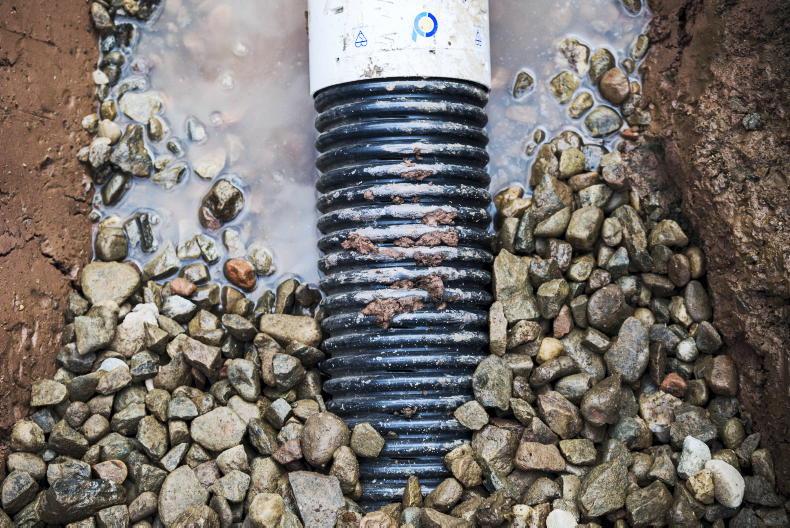
A permeable layer is the zone in the soil where water moves. When the test pit is dug, the point at which water enters the hole is the permeable layer.
Free-draining soils are very permeable, meaning water can easily flow down the soil profile.
In heavy soils, there will be permeable and impermeable layers, which impede water flow.
Teagasc advises to place drains in the permeable layer. This ensures that water will be able to move towards the drain and get away, thereby lowering the water table and allowing surface water to infiltrate downwards.
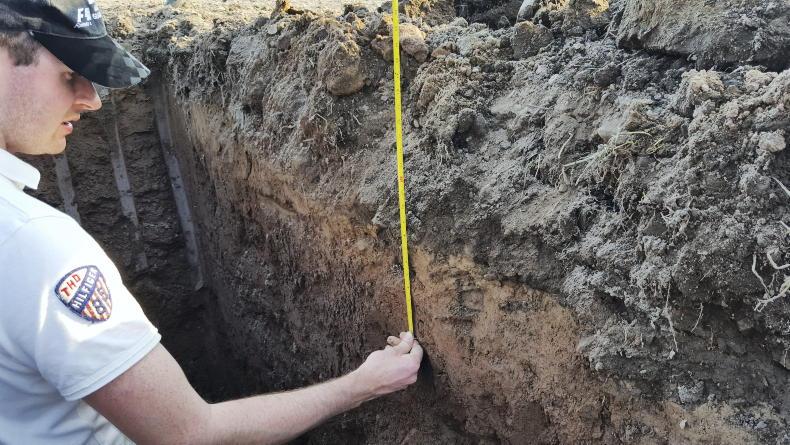
Teagasc drainage experts James O'Loughlin and Pat Tuohy visit dairy farmers Robin Clements and Kevin McGrade in Tyrone.
These drains are often deep, at 1.5m to 2.5m deep and 15m to 20m apart, so they are slow to install and require a deep outfall, but they have proven to be extremely effective.
In many cases, there will be no obvious permeable layer and so a shallow drainage system will be required.
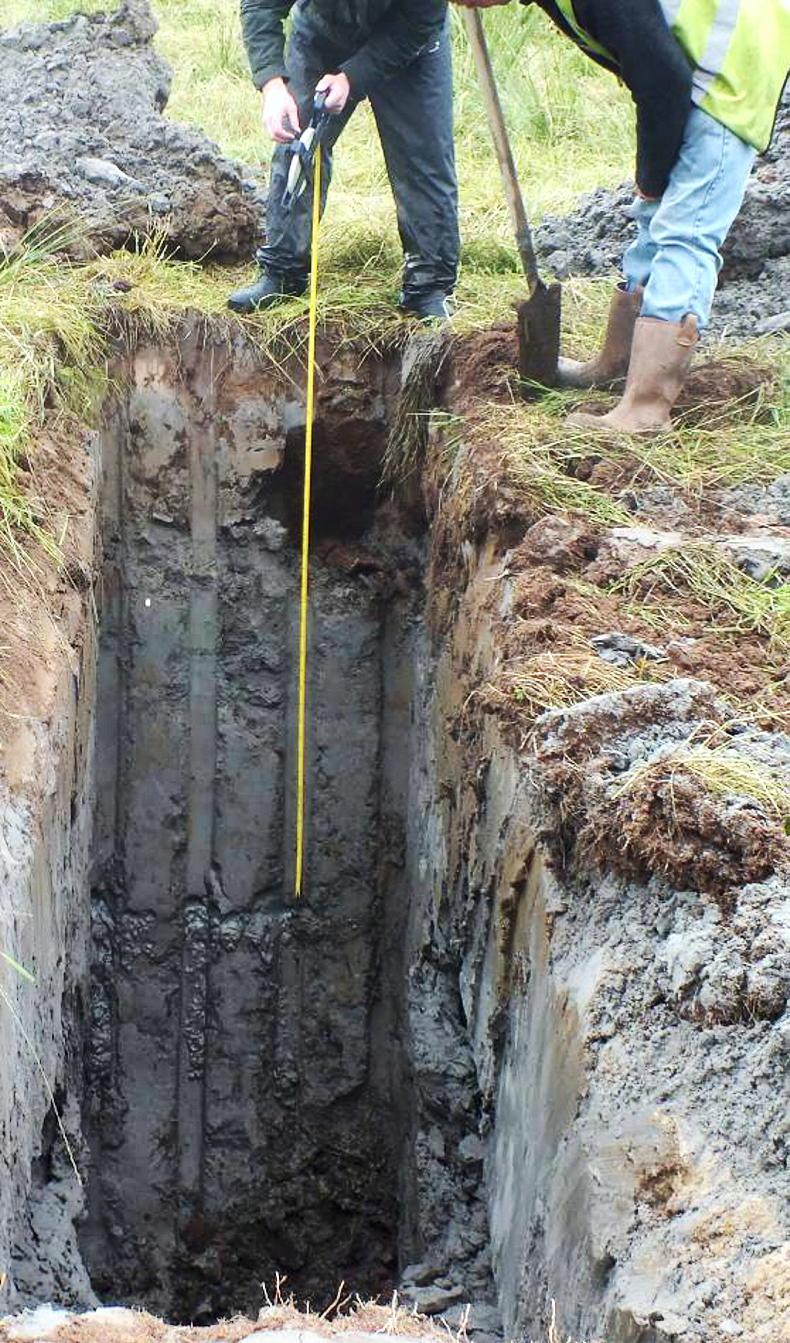
These drainage systems are very common in Ireland, but are less effective than the deep drainage systems.
Shallow drainage systems are placed near the surface at approximately 1m deep and located about 15m apart.
Because they are usually placed in an impermeable layer, some form of mechanical interference with the soil in between the drains will be required. This usually takes the form of naked or gravel mole ploughing, or sub-soiling.
Over the course of the programme, average herd size has increased from 78 cows in 2011 to 103 cows in 2020.
During that time, production per cow and stocking rate have increased and, as a result, milk solids production per hectare on the milking platform has increased from 850kg/ha in 2011 to 1,405kg/ha in 2020.
Meal feeding rates per cow averaged just over 1t/cow in 2020, with a range of 750kg/cow to 1,194kg/cow.
Average herd EBI is €139, which is €23 higher than the national average. Fertility performance is OK, with an average six-week calving rate of 83% in 2020, up from 65% in 2014.
It’s clear that there has been a strong focus on breeding a high-EBI cow that is fertile and can convert grass to milk solids in an efficient manner.
Despite farming on heavy soils, farmers in the programme have embraced high-EBI Holstein Friesian and Jersey crossbred cows. The system of farming doesn’t change, even though soil type does.
Average annual rainfall on the programme farms is 1,259mm. Kiskeam in north Cork is the wettest farm in the programme, recording an annual rainfall of 1,697mm in 2020.
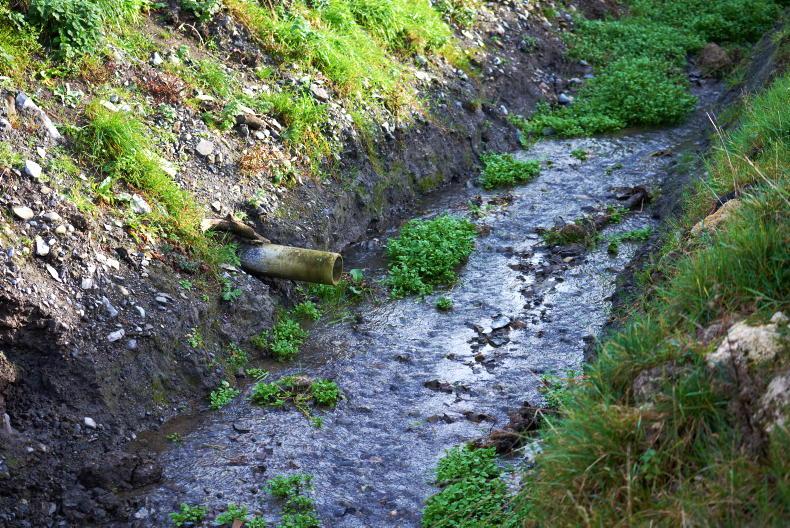
David Farrell and his son Peter on their farm in Kilmessan, Co Meath. \ Barry Cronin
Without adequate grazing infrastructure, it will be impossible to achieve sufficient grazings on these heavy farms. Each farm has invested heavily in roadways, including spur roads.
On John O’Sullivan’s farm in Castleisland, Co Kerry, there is a roadway within 50m of almost every part of the farm. This comes at a significant cost, but enables them to capitalise on the returns from growing more grass.
The cost of drainage varies, depending on what method and materials are used. The average cost of the drainage systems installed on the programme farms was €2,400/ac.
On average, the drained sites increased grass growth by between 4t and 7t DM/ha after the work was complete. Performance has been persistent, seven years after the initial work was complete.
Teagasc says the payback on the sums invested will be five to six years. Ensuring the drainage system is properly maintained by cleaning and rodding drains will enhance its lifespan.

Pat Touhy and James O' Loughlin check on the sample roadways that will be on view in the Infastructure Village. \ Donal O'Leary
The heavy soils programme has been one of the most beneficial programmes undertaken by Teagasc in the last decade.
The farmers involved and the Teagasc team and now retired James O’Loughlin all deserve credit for its success.
The next leg of the programme is to look at environmental impacts of drainage.
In terms of carbon, draining mineral soils is good, but draining peat is not.
For the last 10 years, the Teagasc heavy soils programme has been working with commercial dairy farmers to chart a path for dairy on heavy soils.
About 30% of farmland in Ireland is classed as heavy or poorly drained and a further 50% is classed as marginal.
These soils tend to be located in high rainfall areas, which exacerbates the issue and makes farming these soils even more difficult.
There are 10 farmers in the programme – two in Cork and Kerry and one each in Limerick, Clare, Tipperary, Mayo, Monaghan and Cavan.
The big thing that jumps out from the recently published report on the programme is that these farms are very profitable, despite their challenges.
Last year, the average whole-farm net profit for the group was €1,844/ha, including direct payments, but excluding own labour and debt repayments.
This financial performance is similar or better than the performance of farmers in other Teagasc programmes, namely the Dairygold and Glanbia joint programmes. This is despite the challenges of soil type and weather in the heavy soils programme.
Achieving this level of performance is not easy, nor did it happen overnight. Looking at the trends in profit over the last decade, it is clear that these heavy soils farmers are more exposed to higher costs.
The high-cost years of 2012, 2013 and 2018 were related to bad weather, with 2012 exceptionally wet, while 2013 and 2018 was characterised by cold and wet springs, followed by dry summers.
The impact of the weather is more pronounced on heavy farms, leading to increased meal and silage costs and lower milk solids output.
The following are some key points from the heavy soils programme;
The biggest challenge with heavy soils is not drainage, but soil fertility. Every paddock on every programme farm is sampled annually.
In 2013, average soil pH was 5.7. An intense liming programme has seen pH increase to 6.3 on average.
Potassium levels have remained unchanged at target levels, while phosphorus has increased from 4.9mg/l in 2013 to 5.2mg/l in 2020 (optimum is 5.2 to 8mg/l).
Improving pH and phosphorus status on high clay and organic soils has proven very difficult and remains one of the main lessons from the project.
Nutrient-fixing elements, such as iron and aluminium, lock up phosphorus and calcium, making it unavailable for plant growth.
In 2013, just 2% of soil samples were optimum for soil fertility compared with 11% nationally. This has since increased to 15% of programme soil samples at optimum levels, while the national average is now at 21%.
A major challenge on heavy farms is to maintain high levels of perennial ryegrass in the sward.
Ryegrass is high quality, more responsive to nutrients and grows faster than weed or natural grasses. However, it does not like waterlogged soils, so maintaining high levels of ryegrass on heavy soils is a continual challenge.
Average ryegrass content varies from year to year and the average across all programme farms in 2020 was 24%, ranging from 28% down to 14%.
Maintaining a high ryegrass content is dependent on good drainage, good soil fertility and regular reseeding.
Reseeding without addressing the underlying drainage or soil fertility issues will result in high ryegrass mortality and a poor return on investment in reseeding.
Average grass growth on the programme farms in 2020 was 12.3t DM/ha. The lowest average growth was in 2012 at 7.3t DM/ha and the highest was in 2019 at 13.5t DM/ha.
3 Choose the right drain type
One of the big lessons from the project is the importance of the test pit.
The test pit, which identifies the soil type and if and where a permeable layer exists, should be 2m to 3m deep.

A permeable layer is the zone in the soil where water moves. When the test pit is dug, the point at which water enters the hole is the permeable layer.
Free-draining soils are very permeable, meaning water can easily flow down the soil profile.
In heavy soils, there will be permeable and impermeable layers, which impede water flow.
Teagasc advises to place drains in the permeable layer. This ensures that water will be able to move towards the drain and get away, thereby lowering the water table and allowing surface water to infiltrate downwards.

Teagasc drainage experts James O'Loughlin and Pat Tuohy visit dairy farmers Robin Clements and Kevin McGrade in Tyrone.
These drains are often deep, at 1.5m to 2.5m deep and 15m to 20m apart, so they are slow to install and require a deep outfall, but they have proven to be extremely effective.
In many cases, there will be no obvious permeable layer and so a shallow drainage system will be required.

These drainage systems are very common in Ireland, but are less effective than the deep drainage systems.
Shallow drainage systems are placed near the surface at approximately 1m deep and located about 15m apart.
Because they are usually placed in an impermeable layer, some form of mechanical interference with the soil in between the drains will be required. This usually takes the form of naked or gravel mole ploughing, or sub-soiling.
Over the course of the programme, average herd size has increased from 78 cows in 2011 to 103 cows in 2020.
During that time, production per cow and stocking rate have increased and, as a result, milk solids production per hectare on the milking platform has increased from 850kg/ha in 2011 to 1,405kg/ha in 2020.
Meal feeding rates per cow averaged just over 1t/cow in 2020, with a range of 750kg/cow to 1,194kg/cow.
Average herd EBI is €139, which is €23 higher than the national average. Fertility performance is OK, with an average six-week calving rate of 83% in 2020, up from 65% in 2014.
It’s clear that there has been a strong focus on breeding a high-EBI cow that is fertile and can convert grass to milk solids in an efficient manner.
Despite farming on heavy soils, farmers in the programme have embraced high-EBI Holstein Friesian and Jersey crossbred cows. The system of farming doesn’t change, even though soil type does.
Average annual rainfall on the programme farms is 1,259mm. Kiskeam in north Cork is the wettest farm in the programme, recording an annual rainfall of 1,697mm in 2020.

David Farrell and his son Peter on their farm in Kilmessan, Co Meath. \ Barry Cronin
Without adequate grazing infrastructure, it will be impossible to achieve sufficient grazings on these heavy farms. Each farm has invested heavily in roadways, including spur roads.
On John O’Sullivan’s farm in Castleisland, Co Kerry, there is a roadway within 50m of almost every part of the farm. This comes at a significant cost, but enables them to capitalise on the returns from growing more grass.
The cost of drainage varies, depending on what method and materials are used. The average cost of the drainage systems installed on the programme farms was €2,400/ac.
On average, the drained sites increased grass growth by between 4t and 7t DM/ha after the work was complete. Performance has been persistent, seven years after the initial work was complete.
Teagasc says the payback on the sums invested will be five to six years. Ensuring the drainage system is properly maintained by cleaning and rodding drains will enhance its lifespan.

Pat Touhy and James O' Loughlin check on the sample roadways that will be on view in the Infastructure Village. \ Donal O'Leary
The heavy soils programme has been one of the most beneficial programmes undertaken by Teagasc in the last decade.
The farmers involved and the Teagasc team and now retired James O’Loughlin all deserve credit for its success.
The next leg of the programme is to look at environmental impacts of drainage.
In terms of carbon, draining mineral soils is good, but draining peat is not.









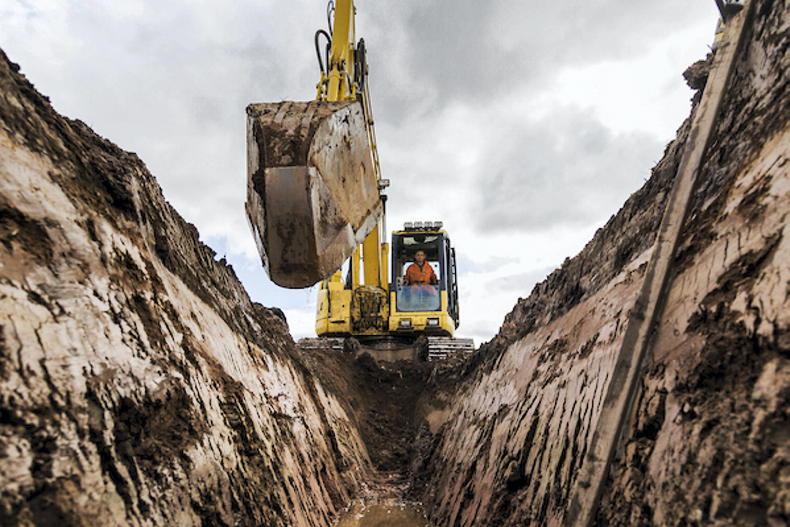


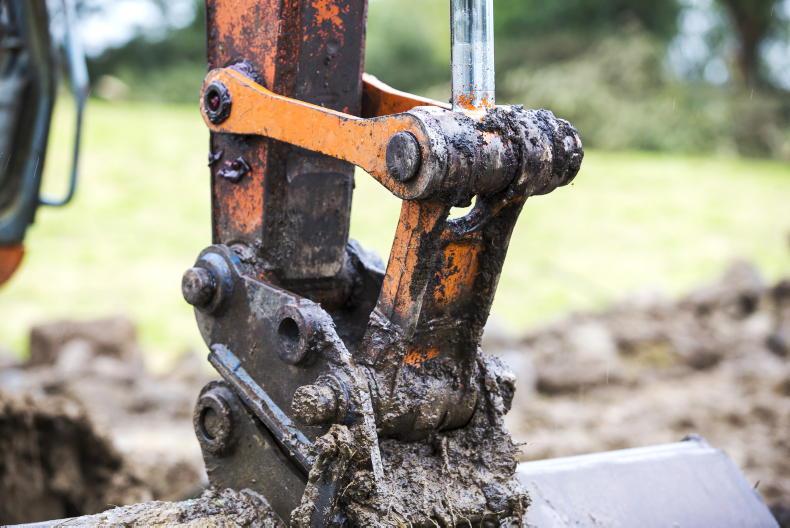
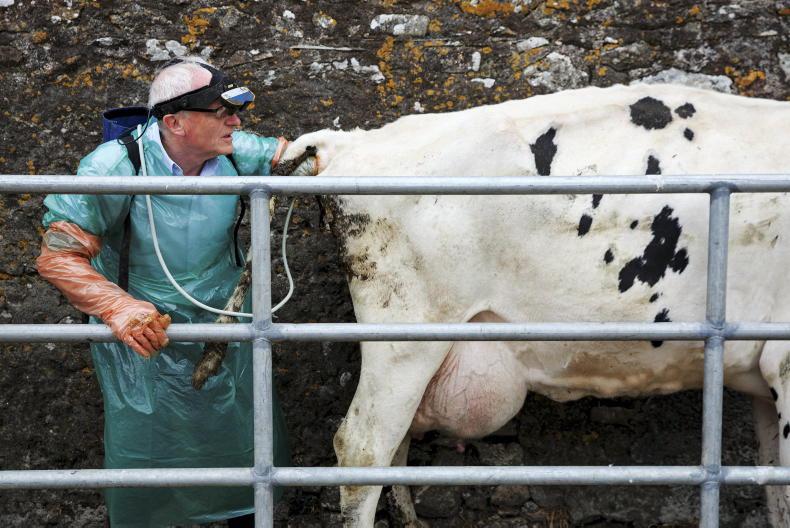
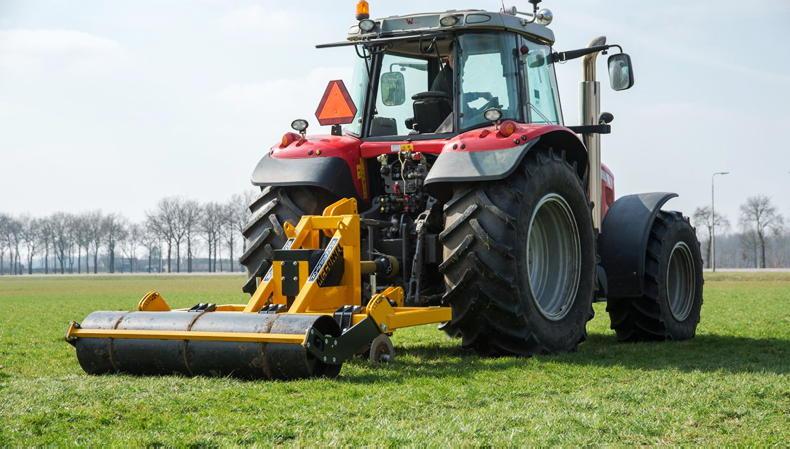
SHARING OPTIONS